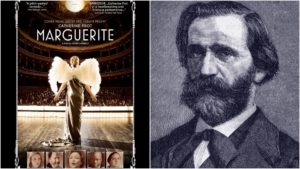
Opera Meets Film: How Passages From ‘La Traviata,’ ‘Pagliacci’ Shape The Tone of ‘Marguerite’
By David Salazar“Opera Meets Film” is a feature dedicated to exploring the way that opera has been employed in cinema. We will select a section or a film in its entirety, highlighting the impact that utilizing the operatic form or sections from an opera can alter our perception of a film that we are viewing. This week’s installment will look at “Marguerite.”
Last week, we took a rather big look at the contrasting interpretations of the life of Florence Foster Jenkins as seen in the films “Marguerite” and “Florence Foster Jenkins.” While the latter has some opera, it doesn’t really delve deep into its potential as an exploration of character.
“Marguerite” does. And it does it in a subtle manner.
Opera and music are at the forefront of “Marguerite,” the opening of the film featuring the music of Handel to contextualize the world that the film will occupy. This music serves as a means of establishing the contrasts between good singing and whatever Marguerite does.
But opera comes into play to establish a few aspects of Marguerite’s character and her ultimate tragic fate. While we might laugh at her rendition of the “Der Hölle Rache” or “Voi che sapete,” other moments of diegetic music win us to her cause.
Verdi’s “Addio del passato” is the leitmotif for Marguerite’s tragic fate. We hear it twice and both times, the imagery emphasizes the unsteady chandelier in her lavish studio. The aria’s tragic nature appears early in the film. She’s just had a discussion with her husband and lies on the couch in the room alone, the music only emphasizing her isolation.
It returns near the end after she has just discovered her husband’s love affair with similar imagery. Now the meaning is even more potent thanks to the call-back and context. This time around, watching the scene and listening to “Addio del passato,” you can’t help but feel the looming death of Marguerite.
And while the Verdi passage plays a major role in how the film’s tragic tone settles in, another scene plays a crucial role.
At the midpoint of the film, Marguerite heads to the opera to watch “Pagliacci” and her eventual teacher, Atos Pezzino. We hear the tragic “Vesti La Giubba” and the choice of editing from Pezzino’s closeup to the reactions of Marguerite emphasize this idea that he is speaking to her directly. Of course, in this aria, Canio emphasizes the tragic nature of having to overlook his pain and suffering and put on a good show. The irony is that this idea applies to Marguerite herself, but she is unaware of her pain and suffering and people enjoy her show not because of her, but in spite of her. Like Canio, she is a joke that everyone laughs at behind their back. Nedda is making a fool of him and everyone knows, while Marguerite is still unaware of her situation. The way the scene plays out, one almost feels like the aria is a warning to her, even if it is delivered by one of the people that will ultimately be responsible for her downfall.
The film ends on one more operatic moment – that of “Casta Diva.” As she walks on stage for her performance, Marguerite starts to sing the famed Bellini melody, eliciting ridicule from the audience. But suddenly, her voice transforms and we hear it beautifully. Others in the audience seem to hear it too, even if it truly never gets there. But what the film manages here is to give us a glimpse at what Marguerite heard when she sang. She heard a beautiful voice and it is this beauty that the others hear when they understand her bravery and power. Her defiance and confidence in going on stage and risking it all.
But tragedy strikes and her voice goes silent in a gut-wrenching sound and visual edit.
These opera selections ultimately serve to emphasize the tone of the film as that of a tragic one. The audience is invited to laugh quite a bit at Marguerite’s expense, but these inclusions are a reminder of her frail nature.


